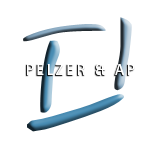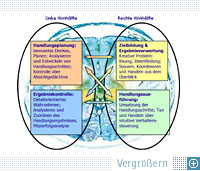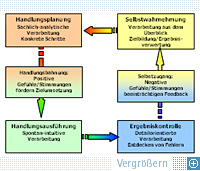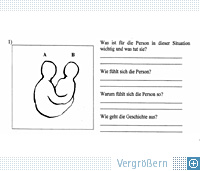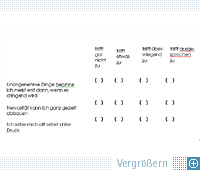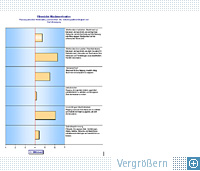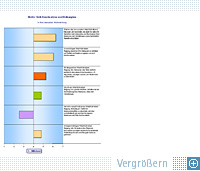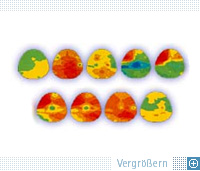| Search Contact Company Info Client server | |||||||
|
|
|||||||
|
|
Identification of success-critical key skills
EOS is the precondition for the personal mentoring process
What is EOS?
Professional knowledge is the main prerequisite, but the so-called “soft skills” are the key factors for successful action.
The EOS-Analysis (development oriented self management method) is a method for measuring which soft skill resources and potentials (emotional, personal and social) a person has. These resources and potentials can be measured very precisely with the EOS-Analysis.
With EOS we can create an exact and individual profile of all relevant functionalities of the personality of a specific person. 120 of the most important facets of his or her personality can be measured and analyzed in terms of which of theses soft skills are the most relevant key qualifications for professional success.
We utilize the EOS-Analysis during our ILC-Capabilities Analysis. ILC is an integral method for development leadership abilities for managers in times of change.
An EOS-Analysis can be adapted to a specific company context with individual problems. Company profiles that are created with the help of the EOS-System serve as a basis for company guiding principles and job requirements that serve as benchmarks for the evaluation.
In what areas is EOS implemented?
We utilize EOS in these situations:
Situations of Selection
- Analysis of tasks, job profile
- Recruiting decisions
- Assessment procedures
- Capability analysis
Situations of Development
- Individual coaching
- Team development
- Trainings
ILC-Capabilities Analysis
- Integral training during which individual coaching, team situations and experience-oriented learning are combined
What is included in the EOS-Analysis?
The implementation of an EOS-analysis includes the test in digital form, a 45-page individualized report and several coaching sessions as a mix of live and tele-coaching. We start with a half-day life coaching for explaining the results and to derive the themes of work for the following coaching events. Four more about 2-hour interviews are then held with virtual webcam in the web technologies we use (Skype, Netviewer SAP Connect). It calls are recorded and support the processing of tasks to be carried out between the calls. Finally, it takes a whole day instead of the Life Coaching holds the results and gives an outlook on the future. After about a year, the initial test is repeated and tested whether the coaching goals have been achieved. For this purpose, there is still a development-controlling conversation.
Our coaches work worldwide in three languages: English, German, Dutch. Our consultants are trained by the Institute of Professor Kuhl and are certificated each year.
Which benefits do I gain from EOS?
With the EOS-Analysis precise statements can be made on which capabilities an employee or an applicant has for a specific task, for example for planning, problem solving, leading, stress management, self motivation, willingness for endeavor, handling of failure.
With the EOS-Analysis, precise training methods can be determined that will significantly increase the ability for high performance, to work under pressure or flexibility of an individual. For companies, employess, applicants, coaches and all others, a range of new possibilities to increase efficiency and performance is opened. For selecting and developing employees, new and individual methods for assessment and training can be developed, which will be in complete accordance with the specific demands of a company.
What is measured?
The human capabilities for self-navigation, motivation of self and others, processing of information and handling of moods and emotions are the key personality factors for success in business and private life. We know today that individual, psychological processes form these capabilities.
To visualize these processes, we use he following schematic illustration:
Measurable functions of the EOS-Analysis
The brain distinguishes between four different systems for processing and controlling input and handling of information (see the four colored squares).
Whenever we are active, specific control mechanisms take place in our brain
For example:
- We get from self-awareness: forming of goals, evaluation of an outcome (yellow area)
- to a plan of action: initiating concrete steps (red area)
- to carrying out an action: concrete doing (green area)
- to evaluating the outcome: discovering of mistakes (blue area)
- and back to self-awareness: learning from mistakes.
The ability to quickly switch between brain halves in order to manage socially complex tasks is a sign of “emotional competence”. The switch between the four systems of control in the brain happens through positive and negative emotions. The ability to manage moods and emotions is therefore an essential feature of our emotional competence.
Equally important is how we take in and process information with a specific control mechanism:
Do we work
- from the overview
- from analytical, strategic thinking
- through intuitive control of behavior
- through perception of details
Besides analyzing the handling of emotions and the intake of information, the EOS-Analysis also researches sources for motivation and self-management. Motivation is the primary source for energy and power in our actions. The ability to motivate oneself takes on a special role. It coordinates the already described areas: the assessment and development of one’s ones needs, the motives for action and the autonomous regulation of emotions and moods.
EOS measures personality traits in the areas of:
Self Navigation
- Resistance to stress
- Coping with failure
- Work independently
- Ability to learn
- Self-confidence
- Reliability
- Sense of responsibility
- Personal responsibility
- Setting priorities
- Discipline
- Ability to coordinate
- Time management
- To relate to others
- Empathy
- Knowledge of human nature
- Goal orientation
- Action orientation
- Ability to delegate
- Control of emotions
Motivation
- Ability to assert oneself
- Ability to convince
- Sociability
- Motivation to perform
- Diligence
- Operational readiness
- Ambition
- Service mentality
- Ability to learn
- Ability to show initiative
- Curiosity
- Willingness to deal with information
- Leadership ability
Cognition
- Apprehension
- Analytical, concept oriented thinking
- Confident appearance
- Meticulous, reliable work ethic
- Assiduousness
- Identify completion signals
- Active listening
- Argumentation skills
Interaction of cognitive Systems
- Ability to communicate
- Flexibility
- Reaction to innovation
- Ability to manage conflicts/ compromises
- Organizational skills
- Negotiation skills
- Capacity for teamwork
- Ability to accept criticism
- Judgmental abilities
- Ability to lead
Emotion
- Sociable behavior
- Inner calmness
- Ability to excite
- Positive attitude
- Optimism
- Freundlichkeit
- Friendliness
How does it work?
The Analysis is made online on your computer or on location. You can perform the EOS-Analysis in the comfort of your office or at home. It will take about 2,5 to 3 hours.
The EOS-Analysis consists of several parts. The first part, for example, contains questions regarding your personal qualifications and your current professional environment. The second part poses direct questions to your every day work as a manger and asks for your personal evaluation. The third part works with images that depict social situations. You are asked to comment on them and to develop them further (OPT: Operander Motiv Test).
Example for an image question:
Within the sscope of the EOS-Analysis you are asked to analyse and describe different situations.
Example for a self evaluation:
Generally the questions are formulated for an easy and spontaneous answer. An Evaluation of your answer is made through numerous control questions.
How is the end result displayed?
You will receive a broad written evaluation (about 60 Pages) with more than 80 individual graphically illustrated evaluation parameters. Your results are set against your cohort. We will discuss the result with you in a 3-hour coaching. The evaluation and the coaching are prerequisites for the ILC-Training, coaching and the ILC-Capability Analysis.
Overview: Power motivation
A close fit between strength of motivation, personal style, the ability to self regulate and moods.
What differentiates the EOS-Analysis from other methods?
EOS differentiates between first- second and third reaction
- First reaction
The spontaneous reaction from a person confronted with a new situation. In this stage no motives or mechanism of control sets in. - Second reaction
It is what a person makes out of a first reaction. It is important for the ability to decide and act and consists of conscious and unconscious motives (power, performance, relationship) that are the driving force for action of the individual. - Third reaction
It shows to what extend a person is able to navigate in difficult or stressful situation, meaning how well he/she is able to cope with difficulties, burdens or insecurities, fears and risks.
The first reaction is measured in the so called “typology methods” (for example DISG, MBTI). It does not however clarify the distinction between different behaviorisms and does not offer a starting point for change.
The second and third reaction clarifies the different behaviorisms and offers an individual starting point for change. From these reactions we develop individual training and development measurements. The EOS-Analysis is so precise that it can be used as a tool for evaluation again, after the training has been completed successfully.
Additional differences to other methods:
Measuring instead of testing
The whole picture of all important areas of personality instead of testing isolated traits.
A worldwide unique and innovative evaluation method (Integration of many new scientific conclusions).
Objective methods
EMOSCAN is an objective test that was developed by Prof. Dr. J. Kuhl and his team. This test is based on the stroop-effect and can shortly be offered in cooperation with IMPART, University of Osnabrück, Germany.
www.impart.de
Development-oriented assessment of motivation
No static evaluation. Personality as a dynamic process, not a static structure.
Analysis of underlying causes for greater benefit
The same attribute of achievement (for example: not putting good intentions into action) can have different causes.
Lean coaching and training
Avoidance of unnecessary trainings by determining beforehand the functional areas that demonstrate optimal potential for development (Micro Analysis of relevant functions). With this method, optimal effects are achieved in a short time with small investment.
Complexitiy management
Many functions are being assessed, but only some of them are being communicated to the participant. The complexity of causal chains is only visible to the expert: He can communicate them to the participant in a much simpler form, since he can work with a new process theory of he personality.
On what scientific background is EOS founded?
In the search for a scientifically founded answer, a team of scientists under the lead of Prof. Dr. Julisu Kuhl managed to identify and illustrate personal competences in a very clear form. He was able to differentiate and measure verifiable individual functions that are the basis of action of a personality.
The psychological EOS groundwork stems from the PSI-Theory (Theory of the personality system interation). The PSI-.Theory integrates the large theories of Psychology (for example by Jung, Skinner, Hull, Havlov, Maslow, Rogers) in an interactive System. They give us answeres to these questions:
What is the primary factor for the ability of a person to identify with his goals and tasks? What is the primary reason why a person can actively follow his goals, is creative or can work well with people?
The self-management method (EOS) is the result of more than 20 years of experimental and practical personality- and motivation analysis. With the help of objective measurement methods and new, for example visualization tools for the illustration of brain activity, the individual functions that control a personality could be identified for the first time on a scientific level.
New scientific methods allow to show a brain “at work”
- How a person adapts to a new situation
- How decisions are being made
- How we find solutions in different ways
- How we cope with mistakes and failures
The EOS-Analysis was validated in the developent of these visual methods © Text, changed scan-up AG 2003.
